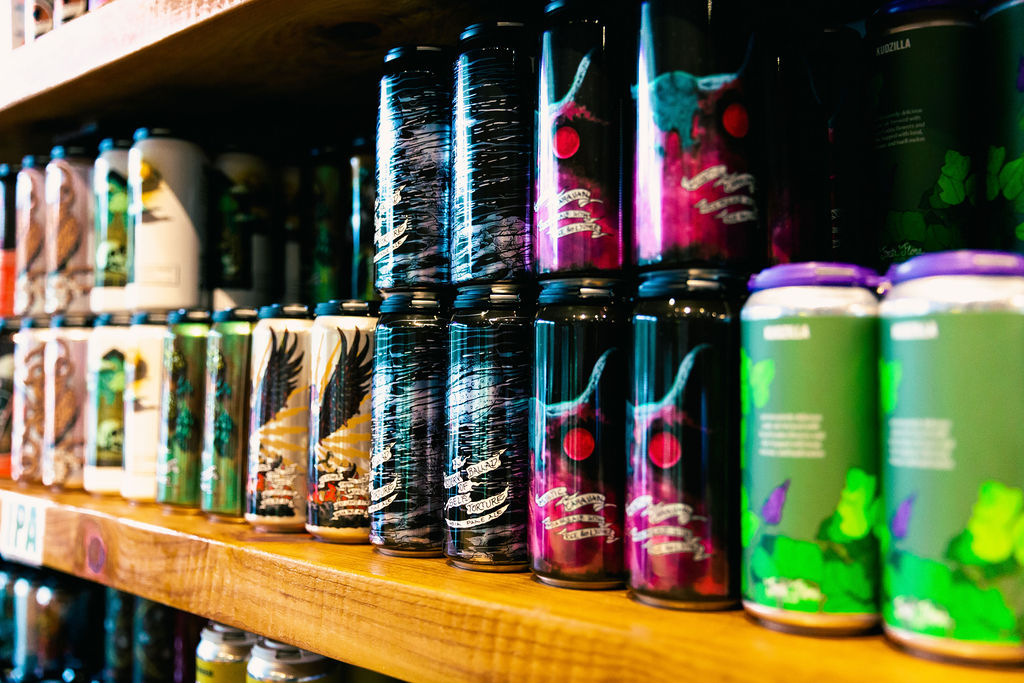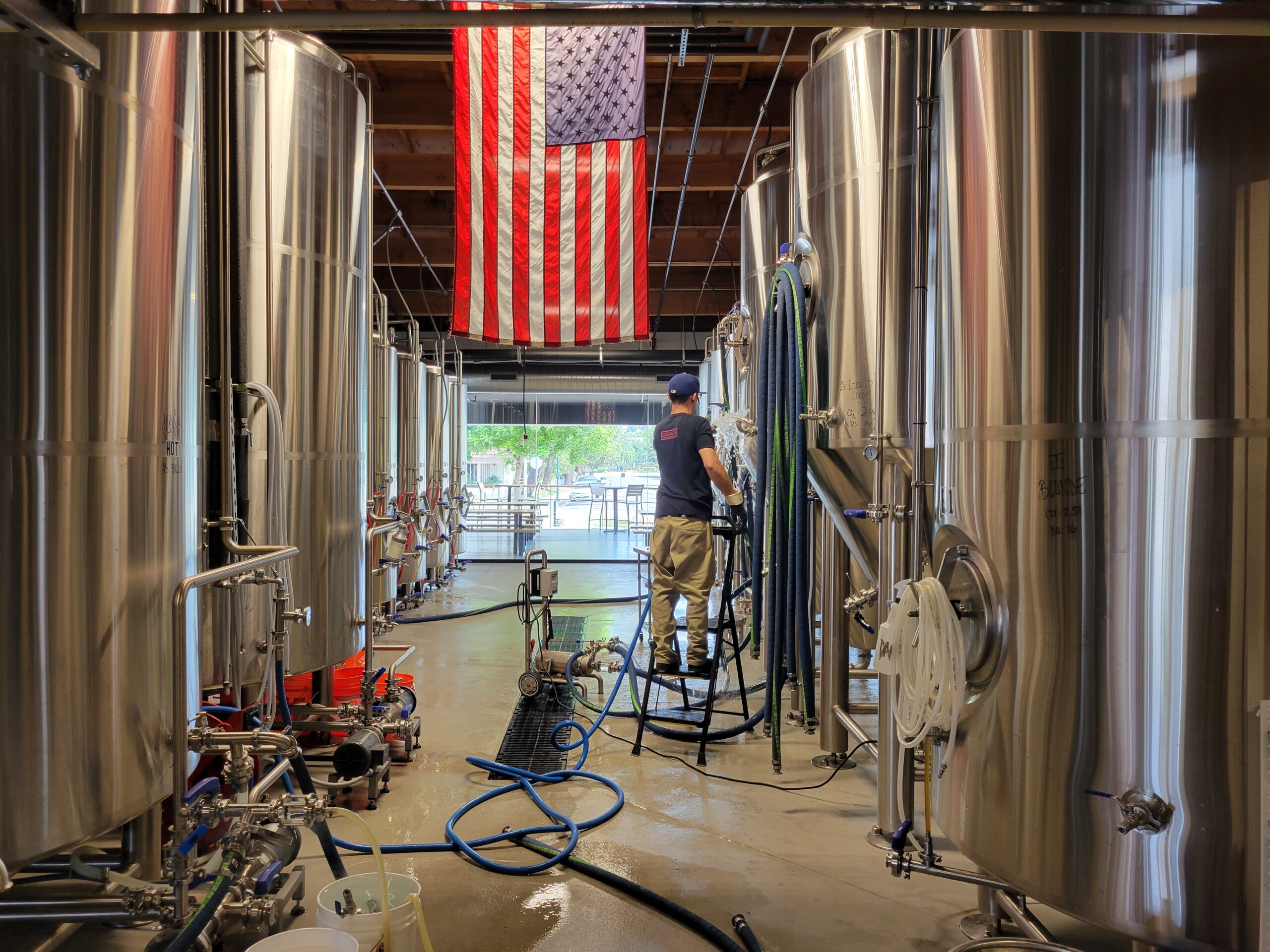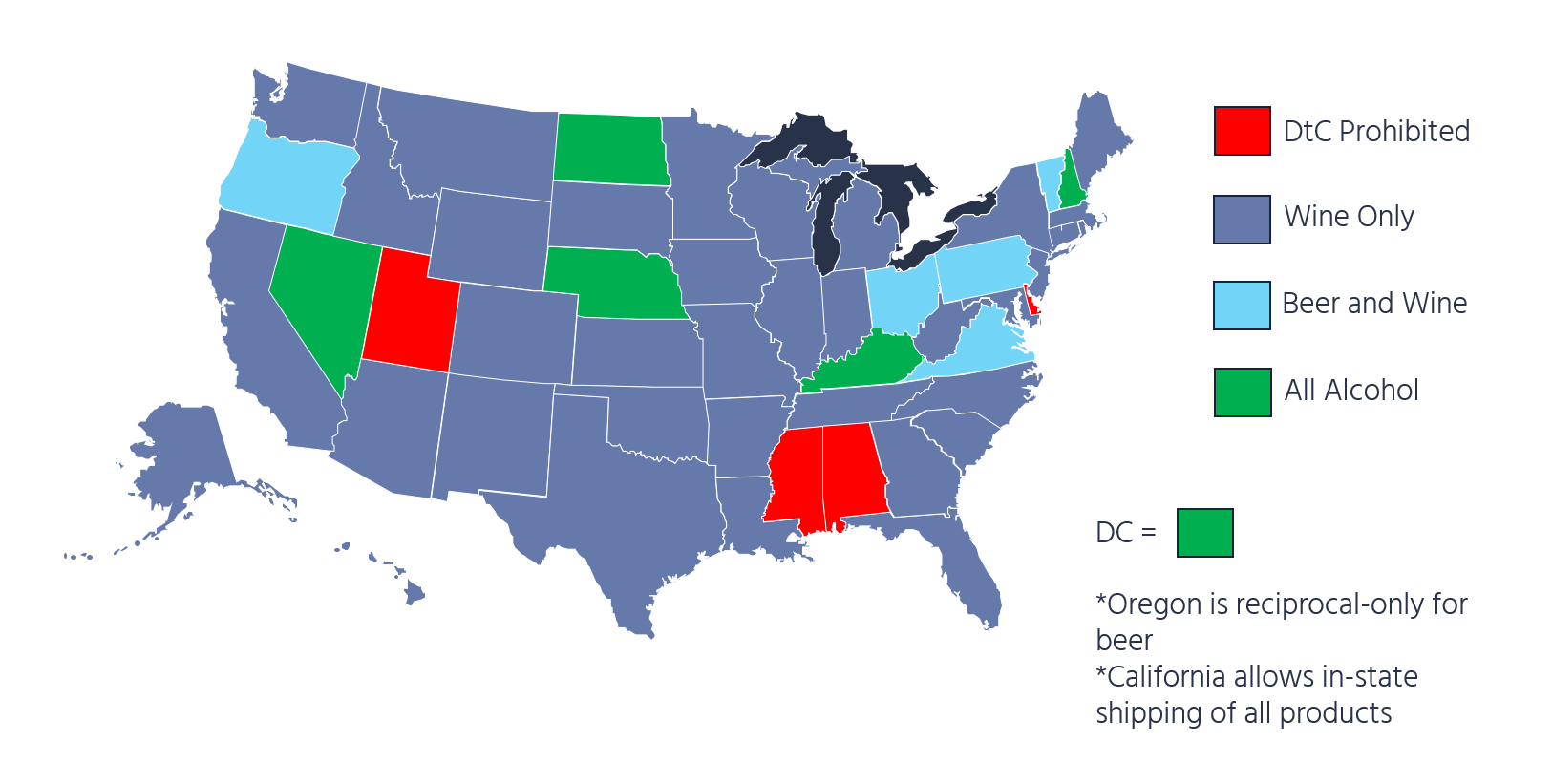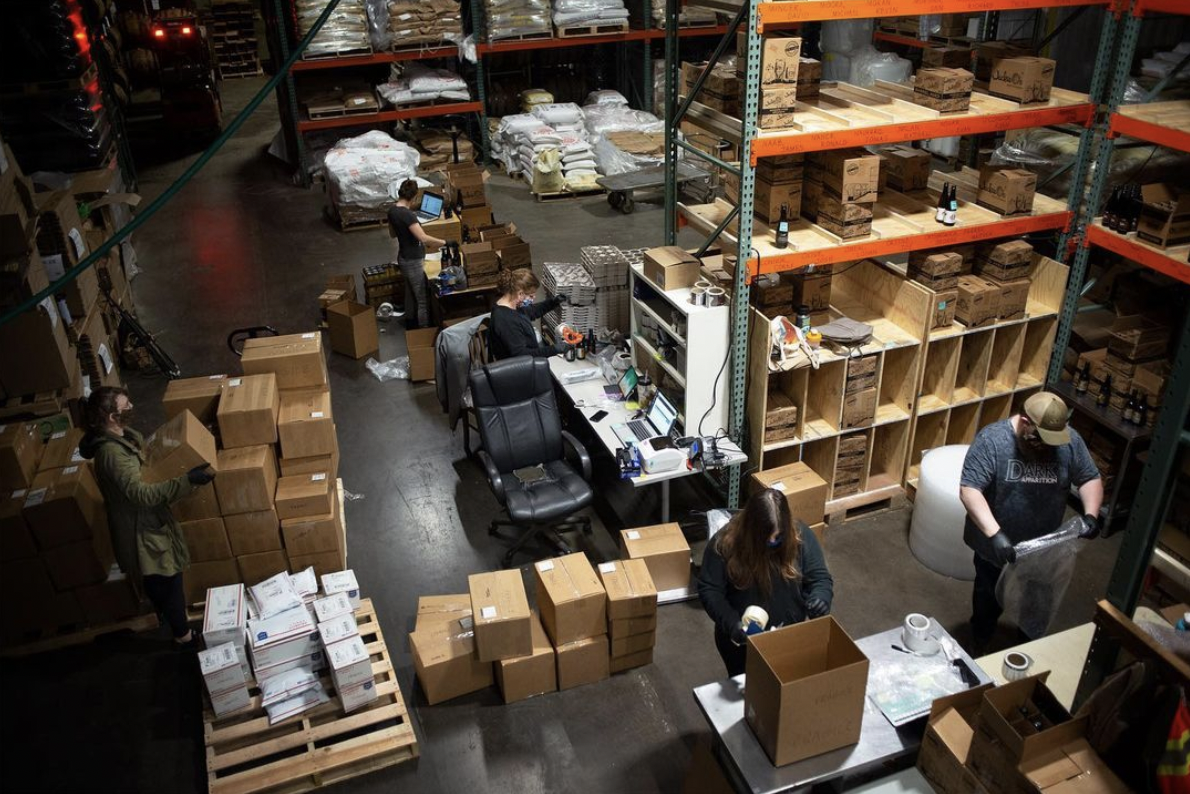Direct to Consumer Shipping (DtC) in the Beverage Industry
Direct to consumer shipping (DtC) has blown up in the last year. Learn the advantages of adopting DtC in your space and how to start today.

These days in the beverage industry, when COVID says “Jump!” businesses are already in mid-air. This industry has always been ever-evolving, but the curve balls are at high speed lately.
But one of the many beautiful things about beverage-selling folks is that they’re always willing to try the latest and greatest thing. And you must, or else you’ll get left behind.
Enter: direct to consumer shipping for alcohol.
What’s Direct to Consumer Shipping?
Direct to consumer shipping, otherwise known as DtC, is formally known as “a way of selling products so that the middleman is lessened or eliminated entirely from the buying process. The supplier sells directly to customers, without any retailer or wholesaler in the middle.”
In short, it means that customers purchase products online and the customer receives them either via delivery or pick up.
10 years ago, this would have made taproom experts scoff. Afterall, isn’t the point of running a taproom to interact directly with guests, serving up the best beverages and customer service face-to-face?
Well, like the other changes rapidly flipping hospitality upside down, we can chalk up the emerging direct to consumer shipping of alcohol craze to COVID. And by emerging, we mean a billion dollar business and growing.
By 2024, 7% of all alcohol sales are projected to come from e-commerce, and beer e-commerce alone is expected to see a $12 billion growth in the next 2.5 years. Uber’s acquisition of Drizly for $1.1 billion is a great example of the large amount of investment that is going into DtC right now.
But, DtC shipping for alcohol is gaining speed for more reasons than just convenience and to promote social distancing. Let’s dive into why else.
Advantages of Direct to Consumer Shipping of Alcohol
While there is simply nothing like a buzzing taproom, there are disadvantages to having your main revenue source come from a single place. Just as having revenue come from merchandise or events, it’s a good idea to start generating revenue from another source like online beverage sales.
Here are some limitations of having taproom-only alcohol sales:
- Capacity: Your space, especially during the pandemic, has a limit to how many people can comfortably enjoy libations within it.
- Geography: You’re only serving those in your taproom’s neighborhood, and the occasional tourists. Think of all the drinkers you could reach via DtC!
- Hours: Your taproom is only open certain times of day. If someone has a hankering for your delicious Sour Ale, they must wait until you’re open for business!
Not only does direct to consumer shipping provide solutions for all of the above, and therefore cast a wider net of customers, there are other advantages of DtC, too.
Process Optimization
Two processes make up DtC: selling and fulfillment. The selling part happens with no labor on your end. (Apart from building an e-commerce website and managing your inventory appropriately. But both of those processes can be set-it-and-forget-it. More on that later!)
Fulfillment is an entirely separate process for DtC, and this allows you to optimize the two processes individually. It’s much easier to identify inefficiencies and iterate on what could work better when it’s broken down like this!
Due to the nature of e-commerce, direct to consumer shipping also allows you to be proactive in your planning. You know the specific monetized demand based on orders, and that lets you leverage the appropriate parties and prepare your products as such.
Jackie O’s Pub & Brewery packing orders from their online store. Image courtesy of Jackie O’s Pub & Brewery.
Product Benefits
Quality assurance is a big advantage of DtC. Because there isn’t a middleman involved and your product is going straight from your hands into your customers’ bellies, you can guarantee they’re receiving top-notch quality.
Packaging your own product also gives you a chance to wow your customers with a little something extra! A thoughtful thank you note or a branded sticker added to the shipment goes a long way in terms of surprising and delighting. Plus, it’s a great way to make a one-time buyer a repeat customer.
Marketing Efforts
Speaking of creating a loyal fanbase, direct to consumer shipping opens many doors for your marketing efforts. Curating fun photos and videos of the products for online purchase make great fodder for your feed, and social media is a necessary medium to connect with your customers on a personal level.
There’s also a great opportunity here to gauge interest for an Insider Program. People are more willing to join your loyalty program in order to access special releases earlier, get discounts on shipments, and other special benefits surrounding DtC. (Ohio’s Jackie O’s has a Loyalty Program called the Imperial Scouts where they reward members with exclusive access to an entirely separate online store!)
What to Prepare For
Direct to consumer shipping is a big, exciting revenue stream to tackle, and you want to make sure all your ducks are in a row. Here are some extra tidbits you’ll need to prepare for before launch.
Increased Demand & Inventory Management
Providing easier and wider access to your beverages means that you’ll have to make more of it! You’ll want to ensure that you have the staff and other resources available to keep up with the increased demand.
An important piece of this puzzle is inventory management. Since you’ll now be selling from an entirely different venue than just your taproom, you need to make sure that a synced POS and inventory system is in place. That way, you’ll be able to track inventory depletions in real-time, and you’ll avoid the nightmare of selling something that is no longer in stock.
Space Available for Storage and Fulfillment
An area where you can store packing materials and ready-to-go products is another important necessity to consider. You may need to think about space to have a canning line as well.
Canning Costs
Speaking of cans, you should familiarize yourself with the costs of canning your own beverages or ordering pre-printed cans from a third party. When you order pre-printed cans, it generally must be purchased by the truckload, and your demand may not call for that.
Canned beer also costs more than draft beer, so keep that in mind for your books. Before you think about using the existing growlers you already have, note that cans require less storage and weight, low breakage, and preserve goods better.

The brewhouse at Tarantula Hill Brewing Co., an Arryved customer
Fulfillment Options for Direct to Consumer Shipping
There’s a lot to consider when choosing which fulfillment option is right for you and your team. When you’re first beginning to offer DtC, it’s best to start small, gain comfort and traction, and learn your strengths!
Curbside Pickup
This is a great place to start. Allowing customers to pick up their ordered goods at your storefront is the lowest effort option available. Starting small here also allows your team to get the hang of packaging products, handling newfound online demand, and still get face time with guests.
What to consider with curbside pickup:
- When will orders be available for pickup?
- Where will the pickup station be located?
- Will you have a dedicated staff member to handoff packages?
Imperial Scouts is too fun of a name not to mention again. They provide individual lockers for their Scouts, stuff them full of goodies when the products are ready, and require pickups by a certain date. Something similar could work great for your business too, if you have the storage space!
Local Deliveries Only
This is the level up from curbside pickup. Much like Ubereats or your other favorite delivery service, you can dedicate a staff member or two to fulfilling orders locally door to door.
What to consider with local delivery:
- What exact radius are you willing to deliver locally?
- What days and times are local deliveries available?
- Do you have the staff available for a delivery-dedicated employee? Should you use a third party instead?
Shipping Nationally
If you’re feeling comfortable in your direct to consumer shipping abilities, this is the fulfillment option that lets you reach the most amount of thirsty people!
What to consider with national shipping:
- What third party should you use?
- What regulations, licenses, and laws do you need to become familiar with? (More to come on this!)
Craftpeak is a great solution for any of these fulfillment options if you’re in the business of beer and choose to work with a third party. Their platform even helps you build customized online storefronts, integrate with social media and other apps, and grow beer memberships online with brewery-specific features.
Your point of sale may also offer an online sales and shipping service. Arryved POS offers a suite of awesome features for completely free to all customers, and one handy feature is Ship It. This modality makes it easy to ship merchandise across the country!
Let’s Talk Legal
To be frank, shipping alcoholic beverages is complicated, and the state and federal laws around doing it are always changing. Direct to consumer shipping rules vary, and there are strict compliance requirements that you’ll need to adhere to state-to-state. Check out each state’s different rules here.

Map updated August 2002. Image courtesy of Sovos.
Get Started with Direct to Consumer Shipping
State Compliance
Start simple: Are you able to ship booze in your state? What states can you ship to? As seen on the map above, it varies by type of alcohol.
Your business will be required to register with the following:
- The Federal Alcohol and Tobacco Tax and Trade Bureau (TTB)
- State Departments of Revenue (DOR)
- State Alcohol Beverage Control departments (ABC)
You’ll also need to make sure that there’s an age verification process for your online storefront.
Carriers & Packaging
UPS, FedEx, and GLS are all options for third party carriers in direct to consumer shipping. Your packages need to be appropriately labeled as alcohol, and an adult’s signature is required upon delivery, too.
Tax Laws
Much like the laws surrounding DtC of alcoholic beverages, there are also state and federal tax requirements to abide by. As the seller, you will pay taxes on DtC shipments as if they were sold in the destination state. So, if you’re in Nevada shipping beer to Kentucky, you will pay Kentucky taxes on that shipment.
Here are 3 taxes to keep top of mind:
- Sales tax: Consumers pay on the sale of certain goods; sellers file on their sales tax return
- Markup tax: Consumers pay a specific, percentage-based tax on the retail value of alcohol sales; sellers file on a separate return
- Excise tax: Shippers are charged by the unit (e.g., gallon of wine) and the cost is factored into the price of the goods sold to the consumer
Finally, Shipping Logistics
And, of course, you’ll need to figure out the logistics outlined above surrounding your direct to consumer shipping plan. Pick a third party you trust, hire some pickers and packers on staff, and set up in-depth tracking and management processes.
If you get overwhelmed in the process, just remember: you’re diversifying your revenue streams and setting up your business for success in this ever-evolving industry. Your future self (on a yacht with a piña colada in hand) will thank you!
Did a point of sale with a free suite of features perk your ears? Sign up for a free demo from an Arryved POS specialist today, and learn more about how our team supports customers in every step of their business journey—including your shipping needs.

